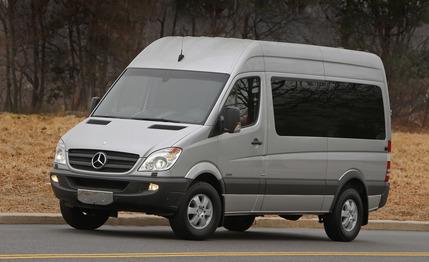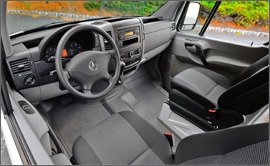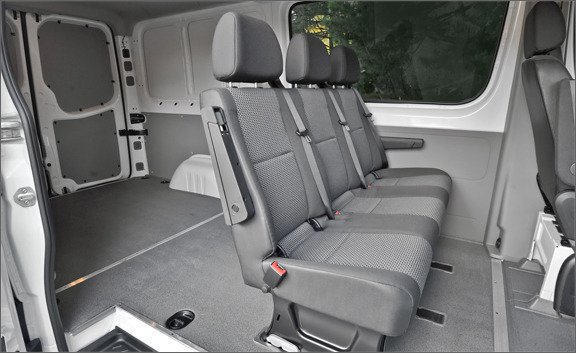
 Short Take Road Test
Short Take Road Test
The Dodge Sprinter is no longer sold as a Dodge—it’s a Mercedes-Benz, now displaying the three-pointed star here as it does in Europe, where it was introduced under the German brand in 1995. It makes sense. With the dissolution of the former DaimlerChrysler, there’s no longer any reason to play dress-up. Since the Sprinter has always been a Mercedes, no pumpkin-into-chariot transformation was involved, although the Sprinter would look appropriate in orange. Indeed, to the naked eye, it simply meant swapping the ram heads on the steering wheel and in the grille for Mercedes regalia.


The Only Place It Fits (In)
Chief among Mercedes’ corporate values is luxury, and if space is the ultimate luxury, the Sprinter trumps even Mercedes’ Maybach 62. Super-luxury automakers are big into offering champagne coolers in their pseudo-limos, but you have enough room in a Sprinter to install a couple of full-size fridges—one for champagne, and one for fresh vegetables and seasonal fruits flown in daily from Madagascar—while leaving enough room to hang a forest of prosciutto thighs.
Of course, Mercedes is nothing if not a status symbol, and here again the Sprinter makes a greater statement than anything else in the family. No matter how universally the S-class might be respected, it’s not nine feet tall. Okay, the Sprinter isn’t, either. It’s a half-inch shy. Even so, it is far and away the most conspicuous Mercedes, and yet there’s a certain honesty to it; you don’t feel like you’ve sold your soul when you loudly announce, “Remember, dear, we’re driving the Mercedes today.”
Benzes have long been employed to usher about heads of state, executives, and other dignitaries, a task for which the Sprinter is the real family champ. For conducting business on the road, as many as three people can each sit in their own full row of seating, giving them more privacy than they will find on the jet to which the Sprinter is shuttling them. Or, instead of the 12-passenger Sprinter we tested, a cargo version is available with a bulkhead separating the front row (the interior volume of which roughly matches that of an entire Ford Crown Victoria) from the rest of the van (the interior volume of which roughly matches that of a small-town water tower). Then, instead of having a little table that folds out of the front seatback, the successful financier could bolt his mahogany desk to the floor and have a true mobile office.
For security in such uses, tinted windows are favored for their ability to keep secret the identity of the passengers. But no tint has greater opacity than metal, and if you don’t want windows in the back of your cargo Sprinter, you don’t have to have them. If you’re concerned about break-ins, Mercedes can fit a security alarm with interior motion sensors to protect your stuff—and you.
Struggles with Motivation
Another hallmark of the Sprinter’s once and again brand is effortless power. The Sprinter’s 3.0-liter turbo-diesel V-6, with all of 188 hp, would doubtless feel effortless in something, but it would have to be much lighter than this van’s 6016 pounds. Although compared to the semis with which the Sprinter driver sees eye to eye, the van’s 11.6-second acquiescence to 60 mph isn’t that bad. Nor is its 18.5-second quarter-mile—at a freeway-legal-ish 73 mph.
Really, that whole horsepower business is an American perception anyway; in Europe, Mercedes has some dog-slow cars it would love to sell you. What matters is the way the Sprinter drives, which is quite nice for something suitable for hosting square dances—with the seats removed, of course. The steering is light, although the flat-top angle of the steering wheel is more like that of a bus than anything else. But the ride is soft, only disturbing passengers when the driver turns, at which point the van lists like a capsizing shrimp boat.


Perhaps the Sprinter’s Mercedes-ness is most evident in its pricing, however. From a base of $40,800, the price of the van tested here swelled to $55,525. That’s thanks to 31 options—not available options, mind you, but only the ones added to this specific vehicle from a list of some 70 possibilities. They ranged from a first-aid kit for $20 to the $2170 V02 Accessory package (it dropped to $1600 on 2011 models), which upgrades the headlights to automatic bixenon units with spray nozzles, pimps out the windshield with a shaded band across the top, and adds rain sensors for the wipers. If this sounds expensive, keep in mind we didn’t even have the long-wheelbase version (which costs almost five grand more), although the Sprinter tested here does have the high roof, which is a $2160 option. The inevitable V-12–powered AMG version should push $200,000.
Actually, don’t believe that fairy tale; no such thing exists or ever will. No matter what company sells the Sprinter here, be it Dodge, Mercedes-Benz, or Freightliner—which is owned by Daimler and will continue to sell Sprinters in the U.S. concurrently with Mercedes, as it did with Dodge—the one thing this van will never do is live up to its name. But it will always be one capacious squash.